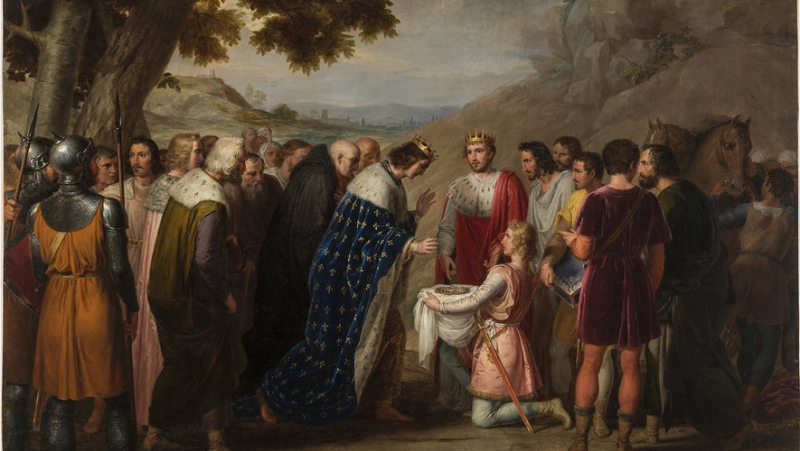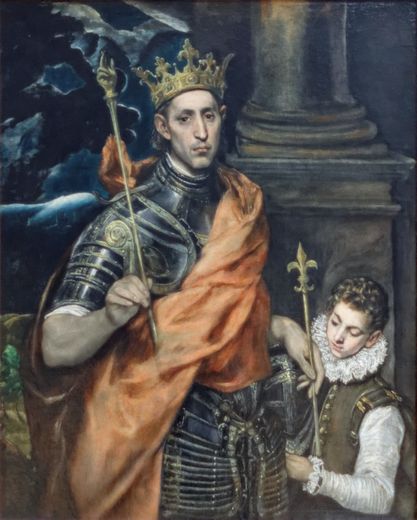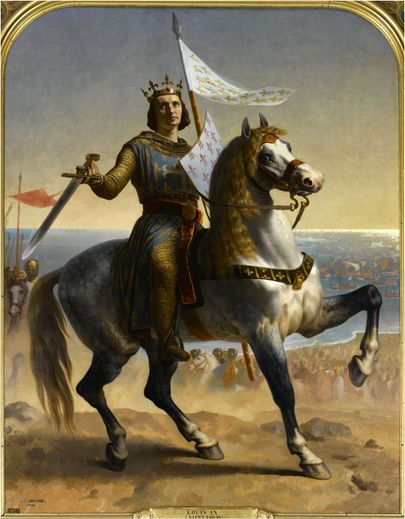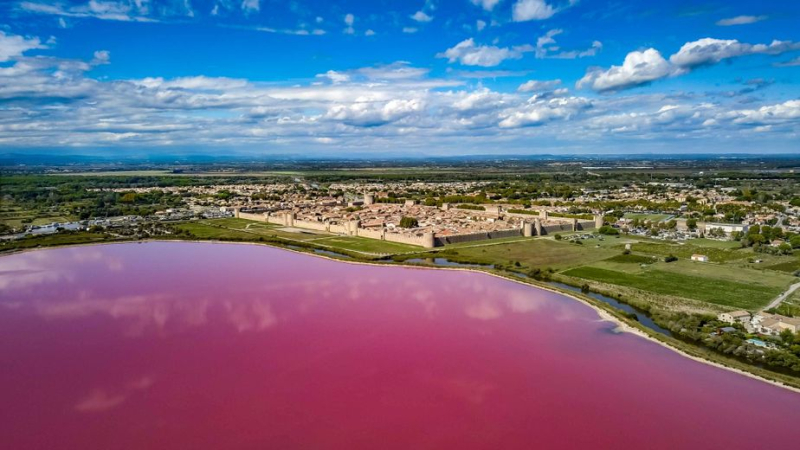HISTORY WEEKEND. The battles of Louis IX against heretics, infidels and Jews weighed on Languedoc

Louis IX recovering Christ's crown of thorns given by Baudouin II. A painting by Rafael Tejeo. CC By SA
The King of France Louis IX, more than 800 years ago, founded a large port at Aigues-Mortes from where he embarked on his two crusades against the Saracens. He had castles built on the ruins of the Cathar castrums, to resist the assaults of Aragon.
Louis IX was born 810 years ago, on April 25, 1214, in a France full of fire and blood. He died 56 years later, in 1270, in a peaceful France. So much for the shortcut to the glory of the man who was even canonized in 1297, twenty-seven years after his death.
Saint Louis, patron saint of Sète, weighed with all his weight on Languedoc. He was the builder of Aigues-Mortes, the one of the castles that we incorrectly call Cathar, the founder of the lower town of Carcassonne. And yet, he will not have "the desire to personally engage in this region where he will never come, with the exception of the marginal and new Aigues-Mortes", underlines the historian Jacques Le Goff in one of the reference works on Louis IX, soberly entitled Saint Louis (editions Gallimard). He leaves "to his officers and, after 1249, to his brother Alphonse de Poitiers, the task of helping the Church to combat the last heretics".
"Kill them all, God will recognize his own"
It must be said that his father Louis VIII and Pope Innocent III cleaned up before his accession to the throne, in the middle of the Albigensian Crusade. The Pope ordered his legate, Arnaud Amaury, to eradicate Catharism. Faced with Raimond-Roger Trencavel, in Béziers, he did not take half measures in 1209: "Kill them all, God will recognize his own".
In 1226, King Louis VIII attacked the Count of Toulouse, Raimond, protector of heretics. "He subdues Languedoc and dies on his return to Paris", victim of dysentery, summarizes Sophie Delmas in her biography also entitled Saint Louis (editions Ellipses).
Louis IX was twelve years old when his father died. His mother, Blanche of Castile, held the helm, facing the barons and the King of England, Henry III. The Count of Toulouse wants to recover part of his land. A compromise was found: he recovered the majority of his possessions but agreed to give them in the long term to the King of France, his daughter having to marry Alphonse de Poitiers, brother of the king.
The Montpellier problem
Louis IX married in 1234 with Marguerite, daughter of Count Raymond Bérenger V of Provence. "This union reinforces the presence of the French monarchy on the shores of the Mediterranean, in this South long dominated by heretics", summarizes Jacques The Goff. They will have eleven children.
At the age of 25, in 1240, he imposed his law on the Viscount of Béziers, Trencavel, who wanted to take back the lands taken from his father in 1209. The armies arriving as reinforcements, the siege of Carcassonne orchestrated by Trencavel failed. In 1242, Raimond VII of Toulouse, allied with the King of England and a host of barons and viscounts, in turn set off on the charge. He seizes Narbonne and Albi. Louis IX sends two armies to Languedoc to force the count to submit. This was done in January 1243. "The pacification of the South will last a few years to complete the reduction of a few isolated points of resistance, the final anti-royal upheavals of the South."
At the gates of Languedoc, the King of France is also at odds with the King of Aragon, James I, who is eyeing Millau, Carcassonne, Gévaudan and Fenouillèdes. Louis IX had Carcassonne fortified by surrounding it with fortified castles, known as the five sons of the City: Termes, Peyrepertuse, Aguilar, Quéribus and Puylaurens.
The Montpellier problem was delicate. Marie, the last descendant of the Guilhems, had brought the lordship to her husband, the king of Aragon, but the bishop of Maguelone claimed the suzerainty of the king of France. Louis IX negotiates. The Treaty of Corbeil, in 1258, provided that France drew a line under Catalonia, Cerdanya and Roussillon. Aragon keeps Montpellier but gives up its views on Carcassonne, Béziers, Foix and Narbonne.
Against heretics, infidels and Jews
This diplomacy made Louis IX "the arbiter, the appeaser of Christianity“, according to Jacques Le Goff. But she would later be reproached for it, like the concessions to England, which would be seen as cowardice two centuries later when Joan of Arc drove the English out of France.

Louis IX represented by the painter El Greco. CC By SA
Yet he knows how to be sharp. It introduces a drastic moral order: games of chance and money are prohibited. Prostitutes are driven out of cities. Access to taverns is prohibited. His Catholic faith makes him even firmer… Against heretics first. Then against the infidels, Muslims fought during the two crusades of 1248 and 1270, two bitter failures. And finally against the Jews, marking "the evolution of medieval Christianity from anti-Judaism to ’anti-Semitism", underlines Le Goff.
In 1269, convinced that "impurity" of his kingdom had caused the failure of his first crusade, and before leaving for the second, Louis IX established the rouelle, a piece of fabric that Jews must wear recommended by the papacy, ancestor of the crusade. rsquo;yellow star. Without more success for the Crusaders. The king dies of scurvy in Carthage. For repatriation, the king's body is boiled in wine mixed with water. The heart and entrails are extracted.

Battle of Tunis and death of the king by Jean Fouquet. CC By SA
A royal overhaul of justice
By a Great Ordinance, in 1254, Louis IX sought to moralize the royal administration, to establish the presumption of innocence and to launch judicial investigations.
"Languedoc constitutes a land of choice for investigations, where the Capetian monarchy can particularly try to erase and forget the abuses that took place after 1229 and after 1240-1242 the royal officers committed acts without restraint or shame, taking advantage of the distance from Paris and the repressive context of heresy to the detriment of the populations, considered as vanquished in conquered land, reports Jacques Le Goff.

Painted in the 19th century by Emile Signol. CC By SA

Today, the coast is more than five kilometers from Aigues-Mortes. Mr ANISSET
Aigues-Mortes, new embarkation site for the Crusades
How did the small fishing port of Aigues-Mortes become, in the second half of the 13th century, the departure point for the two crusades of Louis IX ? The king wanted to control the Mediterranean. Narbonne and Montpellier are "politically insecure", recalls Jacques Le Goff. The first is under the influence of the Count of Toulouse, the second that of the King of Aragon. Marseille is Sicilian.
In Saint-Gilles, a mecca for pilgrimages and crusades of the Templar and Hospitaller orders in the 12th century, the Peccais arm of the Rhône is silting up. Louis IX opted for Aigues-Mortes as the place of embarkation. But he does not snub Saint-Gilles. "Aigues-Mortes was nothing at the time, a town just out of the ground, while Saint-Gilles is a place worthy of establishment of the king with his court", assures Lydie Angosto, municipal archivist in Saint-Gilles. There he prepares his spiritual journey towards Jerusalem.
As for Aigues-Mortes, if today the town is more than five kilometers from the coast, this was not the case at the time. "The shore was about twenty meters away and the lagoon offered a natural harbor basin to the city, specifies historian Sophie Delmas. The place is called the port of Eaux-Mortes because of the large bodies of stagnant water that bordered it to the north."
The king bought the land from Psalmodi Abbey, whose monks exploited part of the estate. He developed the port in 1240 and built an imposing round tower, the future Tower of Constance. It serves as both a watchtower and a lighthouse. The ramparts were only completed after the death of Louis IX.
20,000 men
The king had the Cévennes road remodeled with a mixture of "cajolery, concessions and force" , summarizes historian William Jordan. Louis IX removed all tolls and deforested the region. It requires considerable quantities of wood and salt.
20,000 men embark on each crusade. "All these preparations have an exorbitant cost", explains Jacques Le Goff. Not to mention the financing of the crusades themselves… And the money released for the king's ransom, captured by the Saracens in 1249: alone, the equivalent of a year of revenue for the kingdom of France!
A relic of Saint Louis, property of the d’Albenas family, has just been donated in 2024 to Saint-Gilles. Other bone fragments are preserved at Grau-du-Roi and Aigues-Mortes. It remains to be seen whether these relics are authentic. I subscribe to read more




